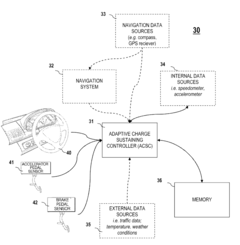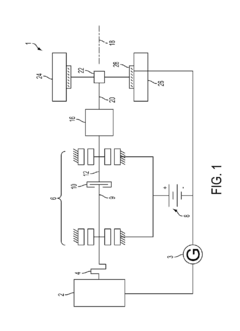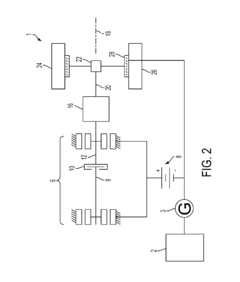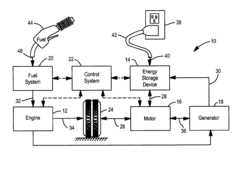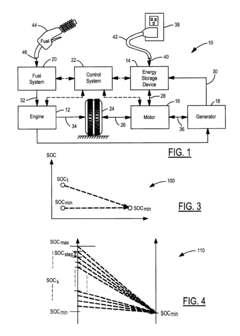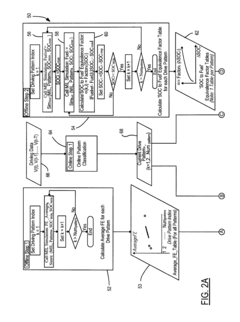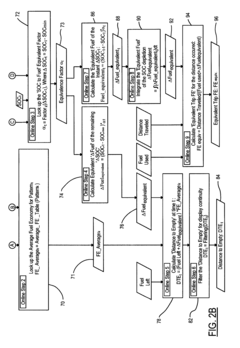How urban transport policies affect PHEV adaptation
AUG 14, 20259 MIN READ
Generate Your Research Report Instantly with AI Agent
Patsnap Eureka helps you evaluate technical feasibility & market potential.
PHEV Policy Background
Plug-in Hybrid Electric Vehicles (PHEVs) have emerged as a promising solution to address urban transportation challenges, combining the benefits of both conventional internal combustion engines and electric powertrains. The policy background surrounding PHEVs is complex and multifaceted, reflecting the evolving priorities of urban planners, environmental regulators, and automotive industry stakeholders.
The genesis of PHEV policies can be traced back to the early 2000s when concerns about climate change and urban air quality began to gain prominence in policy discussions. Initially, these policies were largely focused on incentivizing the adoption of hybrid vehicles, with PHEVs being seen as a natural progression in this technological evolution.
As urban areas grappled with increasing congestion and pollution, policymakers began to recognize the potential of PHEVs to address multiple challenges simultaneously. This led to the development of more targeted policies aimed at promoting PHEV adoption in urban environments. These policies often took the form of financial incentives, such as tax credits, rebates, and reduced registration fees for PHEV owners.
Concurrently, many cities began implementing stricter emissions standards and creating low-emission zones, indirectly boosting the attractiveness of PHEVs. These vehicles offered a compromise between the range anxiety associated with pure electric vehicles and the environmental impact of conventional gasoline-powered cars, making them an ideal fit for urban commuters.
The policy landscape for PHEVs has also been shaped by broader energy and transportation strategies. Many governments have incorporated PHEVs into their plans for reducing dependence on fossil fuels and transitioning towards more sustainable urban mobility systems. This has led to the integration of PHEV-friendly policies into wider urban planning initiatives, including the development of charging infrastructure and the redesign of urban spaces to accommodate alternative fuel vehicles.
However, the policy approach to PHEVs has not been uniform across different urban areas. Some cities have embraced PHEVs as a transitional technology, viewing them as a stepping stone towards full electrification of urban transport. Others have been more cautious, balancing the potential benefits of PHEVs against concerns about their long-term environmental impact and the need for supporting infrastructure.
Recent years have seen a shift in policy focus towards pure electric vehicles, with some urban areas beginning to phase out incentives for PHEVs in favor of more aggressive promotion of fully electric alternatives. This evolving policy landscape reflects the rapid pace of technological change in the automotive sector and the growing urgency of climate action in urban planning.
The genesis of PHEV policies can be traced back to the early 2000s when concerns about climate change and urban air quality began to gain prominence in policy discussions. Initially, these policies were largely focused on incentivizing the adoption of hybrid vehicles, with PHEVs being seen as a natural progression in this technological evolution.
As urban areas grappled with increasing congestion and pollution, policymakers began to recognize the potential of PHEVs to address multiple challenges simultaneously. This led to the development of more targeted policies aimed at promoting PHEV adoption in urban environments. These policies often took the form of financial incentives, such as tax credits, rebates, and reduced registration fees for PHEV owners.
Concurrently, many cities began implementing stricter emissions standards and creating low-emission zones, indirectly boosting the attractiveness of PHEVs. These vehicles offered a compromise between the range anxiety associated with pure electric vehicles and the environmental impact of conventional gasoline-powered cars, making them an ideal fit for urban commuters.
The policy landscape for PHEVs has also been shaped by broader energy and transportation strategies. Many governments have incorporated PHEVs into their plans for reducing dependence on fossil fuels and transitioning towards more sustainable urban mobility systems. This has led to the integration of PHEV-friendly policies into wider urban planning initiatives, including the development of charging infrastructure and the redesign of urban spaces to accommodate alternative fuel vehicles.
However, the policy approach to PHEVs has not been uniform across different urban areas. Some cities have embraced PHEVs as a transitional technology, viewing them as a stepping stone towards full electrification of urban transport. Others have been more cautious, balancing the potential benefits of PHEVs against concerns about their long-term environmental impact and the need for supporting infrastructure.
Recent years have seen a shift in policy focus towards pure electric vehicles, with some urban areas beginning to phase out incentives for PHEVs in favor of more aggressive promotion of fully electric alternatives. This evolving policy landscape reflects the rapid pace of technological change in the automotive sector and the growing urgency of climate action in urban planning.
Urban Mobility Demand
Urban mobility demand has undergone significant changes in recent years, driven by urbanization, technological advancements, and shifting consumer preferences. The increasing population density in urban areas has led to a surge in transportation needs, creating both challenges and opportunities for city planners and policymakers. This demand is characterized by a complex interplay of factors, including commuting patterns, leisure travel, and the movement of goods within urban environments.
The rise of smart city initiatives and the integration of digital technologies have reshaped urban mobility landscapes. Real-time traffic management systems, mobile applications for route planning and ride-sharing, and the emergence of micromobility solutions have all contributed to a more dynamic and responsive urban transport ecosystem. These innovations have not only improved the efficiency of existing transportation networks but also created new modes of travel that cater to diverse user needs.
Environmental concerns and sustainability goals have become increasingly important drivers of urban mobility demand. As cities strive to reduce their carbon footprint and improve air quality, there is a growing emphasis on clean and energy-efficient transportation options. This shift in priorities has led to increased demand for electric vehicles, including Plug-in Hybrid Electric Vehicles (PHEVs), as well as expanded public transit systems and infrastructure for non-motorized transport such as cycling and walking.
The COVID-19 pandemic has also had a profound impact on urban mobility patterns, accelerating certain trends while disrupting others. Remote work arrangements have reduced peak-hour commuting in many cities, while concerns about social distancing have led to a temporary decline in public transit ridership. Conversely, there has been an uptick in demand for personal mobility options, including private vehicles and bicycles, as people seek to minimize exposure to shared spaces.
Economic factors play a crucial role in shaping urban mobility demand. The cost of vehicle ownership, fuel prices, and public transit fares all influence individual transportation choices. Additionally, the growth of the sharing economy has introduced new mobility models, such as car-sharing and bike-sharing services, which offer flexibility and cost-effectiveness for urban residents.
As cities continue to evolve, the demand for seamless, multimodal transportation solutions is increasing. Urban dwellers expect integrated systems that allow for easy transitions between different modes of transport, from public buses and trains to shared bikes and electric scooters. This demand for connectivity and convenience is driving investments in mobility-as-a-service (MaaS) platforms and interoperable payment systems.
The adoption of PHEVs is intricately linked to these broader urban mobility trends. As cities implement policies to promote sustainable transportation, the demand for PHEVs is likely to grow. However, the extent of this growth will depend on how well urban transport policies address key factors such as charging infrastructure, incentives for clean vehicle adoption, and integration with existing transportation networks.
The rise of smart city initiatives and the integration of digital technologies have reshaped urban mobility landscapes. Real-time traffic management systems, mobile applications for route planning and ride-sharing, and the emergence of micromobility solutions have all contributed to a more dynamic and responsive urban transport ecosystem. These innovations have not only improved the efficiency of existing transportation networks but also created new modes of travel that cater to diverse user needs.
Environmental concerns and sustainability goals have become increasingly important drivers of urban mobility demand. As cities strive to reduce their carbon footprint and improve air quality, there is a growing emphasis on clean and energy-efficient transportation options. This shift in priorities has led to increased demand for electric vehicles, including Plug-in Hybrid Electric Vehicles (PHEVs), as well as expanded public transit systems and infrastructure for non-motorized transport such as cycling and walking.
The COVID-19 pandemic has also had a profound impact on urban mobility patterns, accelerating certain trends while disrupting others. Remote work arrangements have reduced peak-hour commuting in many cities, while concerns about social distancing have led to a temporary decline in public transit ridership. Conversely, there has been an uptick in demand for personal mobility options, including private vehicles and bicycles, as people seek to minimize exposure to shared spaces.
Economic factors play a crucial role in shaping urban mobility demand. The cost of vehicle ownership, fuel prices, and public transit fares all influence individual transportation choices. Additionally, the growth of the sharing economy has introduced new mobility models, such as car-sharing and bike-sharing services, which offer flexibility and cost-effectiveness for urban residents.
As cities continue to evolve, the demand for seamless, multimodal transportation solutions is increasing. Urban dwellers expect integrated systems that allow for easy transitions between different modes of transport, from public buses and trains to shared bikes and electric scooters. This demand for connectivity and convenience is driving investments in mobility-as-a-service (MaaS) platforms and interoperable payment systems.
The adoption of PHEVs is intricately linked to these broader urban mobility trends. As cities implement policies to promote sustainable transportation, the demand for PHEVs is likely to grow. However, the extent of this growth will depend on how well urban transport policies address key factors such as charging infrastructure, incentives for clean vehicle adoption, and integration with existing transportation networks.
PHEV Adoption Barriers
Despite the potential benefits of Plug-in Hybrid Electric Vehicles (PHEVs) in reducing emissions and improving fuel efficiency, several barriers hinder their widespread adoption in urban environments. These obstacles are multifaceted, encompassing technological, economic, and social factors that collectively impede the transition to more sustainable transportation options.
One of the primary barriers to PHEV adoption is the higher upfront cost compared to conventional vehicles. Although PHEVs offer long-term savings through reduced fuel consumption, the initial investment remains a significant deterrent for many consumers. This economic hurdle is particularly pronounced in urban areas where residents may have lower disposable incomes or face higher living costs.
Infrastructure limitations pose another substantial challenge. Many urban areas lack sufficient charging stations, making it difficult for PHEV owners to conveniently recharge their vehicles. This "range anxiety" is especially problematic in densely populated cities where private parking spaces with charging capabilities are scarce. The inadequate charging infrastructure can discourage potential buyers who fear being stranded with a depleted battery.
Consumer awareness and understanding of PHEV technology also present significant barriers. Many urban dwellers may not be fully informed about the benefits of PHEVs or may have misconceptions about their performance and reliability. This knowledge gap can lead to hesitation in adopting new technology, particularly when it involves a substantial financial commitment.
Technical limitations of current PHEV models can also hinder adoption. Issues such as limited electric-only range, longer charging times compared to refueling conventional vehicles, and concerns about battery longevity and replacement costs may deter potential buyers. These technical constraints are particularly relevant in urban settings where short trips are common, but access to charging infrastructure may be limited.
Regulatory uncertainties and inconsistent policy support across different urban areas create additional barriers. The lack of standardized incentives, varying emissions regulations, and fluctuating government support for electric vehicle technologies can create a confusing landscape for consumers and manufacturers alike. This regulatory ambiguity can slow down PHEV adoption rates in cities that lack clear, long-term commitments to supporting electric vehicle technologies.
Lastly, cultural and behavioral factors play a role in PHEV adoption barriers. Urban residents accustomed to conventional vehicles may be resistant to change, particularly if they perceive PHEVs as less convenient or reliable. The need to plan trips around charging opportunities and potential changes in driving habits can be seen as inconveniences that outweigh the benefits of PHEV ownership.
One of the primary barriers to PHEV adoption is the higher upfront cost compared to conventional vehicles. Although PHEVs offer long-term savings through reduced fuel consumption, the initial investment remains a significant deterrent for many consumers. This economic hurdle is particularly pronounced in urban areas where residents may have lower disposable incomes or face higher living costs.
Infrastructure limitations pose another substantial challenge. Many urban areas lack sufficient charging stations, making it difficult for PHEV owners to conveniently recharge their vehicles. This "range anxiety" is especially problematic in densely populated cities where private parking spaces with charging capabilities are scarce. The inadequate charging infrastructure can discourage potential buyers who fear being stranded with a depleted battery.
Consumer awareness and understanding of PHEV technology also present significant barriers. Many urban dwellers may not be fully informed about the benefits of PHEVs or may have misconceptions about their performance and reliability. This knowledge gap can lead to hesitation in adopting new technology, particularly when it involves a substantial financial commitment.
Technical limitations of current PHEV models can also hinder adoption. Issues such as limited electric-only range, longer charging times compared to refueling conventional vehicles, and concerns about battery longevity and replacement costs may deter potential buyers. These technical constraints are particularly relevant in urban settings where short trips are common, but access to charging infrastructure may be limited.
Regulatory uncertainties and inconsistent policy support across different urban areas create additional barriers. The lack of standardized incentives, varying emissions regulations, and fluctuating government support for electric vehicle technologies can create a confusing landscape for consumers and manufacturers alike. This regulatory ambiguity can slow down PHEV adoption rates in cities that lack clear, long-term commitments to supporting electric vehicle technologies.
Lastly, cultural and behavioral factors play a role in PHEV adoption barriers. Urban residents accustomed to conventional vehicles may be resistant to change, particularly if they perceive PHEVs as less convenient or reliable. The need to plan trips around charging opportunities and potential changes in driving habits can be seen as inconveniences that outweigh the benefits of PHEV ownership.
Current PHEV Incentives
01 Battery management and charging systems
PHEV adaptation involves advanced battery management and charging systems. This includes optimizing battery performance, implementing smart charging strategies, and developing efficient power distribution systems to maximize electric range and overall vehicle efficiency.- Battery management and charging systems: Advanced battery management and charging systems are crucial for PHEV adaptation. These systems optimize battery performance, extend range, and improve overall efficiency. They include intelligent charging algorithms, battery health monitoring, and integration with smart grid technologies for efficient energy utilization.
- Powertrain optimization and control: Optimizing the powertrain and its control systems is essential for PHEV adaptation. This involves developing sophisticated algorithms to manage power distribution between the electric motor and internal combustion engine, improving fuel efficiency, and enhancing overall vehicle performance. Advanced control strategies also enable seamless transitions between electric and hybrid modes.
- Regenerative braking and energy recovery: Implementing efficient regenerative braking systems is a key aspect of PHEV adaptation. These systems recover kinetic energy during deceleration and braking, converting it into electrical energy to recharge the battery. Advanced energy recovery techniques maximize the amount of energy recaptured, extending the electric range of the vehicle.
- Vehicle-to-grid (V2G) integration: Adapting PHEVs for vehicle-to-grid integration allows them to interact with the power grid. This technology enables PHEVs to not only charge from the grid but also feed excess energy back, providing grid stability and potential economic benefits for vehicle owners. V2G integration requires advanced communication systems and smart charging infrastructure.
- Lightweight materials and aerodynamic design: Incorporating lightweight materials and improving aerodynamic design are crucial for PHEV adaptation. Using advanced materials like carbon fiber composites and high-strength alloys reduces vehicle weight, while optimizing body shape and components for better aerodynamics decreases drag. These improvements contribute to increased energy efficiency and extended electric range.
02 Powertrain integration and control
Adapting PHEVs requires seamless integration of electric and combustion powertrains. This involves developing sophisticated control algorithms to manage power distribution, optimize energy usage, and ensure smooth transitions between electric and hybrid modes for improved performance and fuel efficiency.Expand Specific Solutions03 Regenerative braking and energy recovery
PHEV adaptation includes implementing advanced regenerative braking systems to recover and store energy during deceleration. This technology helps extend electric range and improve overall energy efficiency by converting kinetic energy into electrical energy for battery recharging.Expand Specific Solutions04 Thermal management and HVAC optimization
Adapting PHEVs involves developing efficient thermal management systems for batteries and powertrains, as well as optimizing HVAC systems. These improvements help maintain optimal operating temperatures, extend battery life, and reduce energy consumption for climate control.Expand Specific Solutions05 Vehicle-to-grid (V2G) integration
PHEV adaptation includes developing V2G capabilities, allowing vehicles to interact with the power grid. This technology enables PHEVs to serve as mobile energy storage units, potentially providing grid support, load balancing, and emergency power supply during outages.Expand Specific Solutions
Key Urban Policymakers
The urban transport policy landscape for PHEV adaptation is in a transitional phase, with market growth accelerating but still in early stages. The global PHEV market size is projected to reach $20 billion by 2026, driven by government incentives and emission regulations. Technologically, PHEVs are maturing but still evolving, with major automakers like Ford, Hyundai, Kia, and Audi investing heavily in R&D. Chinese manufacturers such as Guangzhou Auto, Geely, and SAIC-GM-Wuling are also making significant strides. Research institutions like Jilin University and Beijing Institute of Technology are contributing to technological advancements. The competitive landscape is diverse, with traditional automakers, new entrants, and technology companies vying for market share.
Ford Global Technologies LLC
Technical Solution: Ford has developed a comprehensive approach to PHEV adaptation in urban environments. Their strategy includes smart charging infrastructure integration, utilizing vehicle-to-grid (V2G) technology to support power grid stability during peak hours[1]. Ford's PHEVs are equipped with geofencing technology that automatically switches to electric-only mode in designated low-emission zones[2]. The company has also implemented a data-driven approach to optimize electric range based on urban driving patterns, incorporating machine learning algorithms to predict and suggest the most efficient routes for PHEV users[3]. Additionally, Ford has partnered with city planners to develop PHEV-friendly urban policies, such as dedicated charging lanes and preferential parking for PHEVs[4].
Strengths: Strong integration with smart city infrastructure, advanced geofencing capabilities, and data-driven optimization. Weaknesses: Dependency on city cooperation for policy implementation, potential limitations in cities with less developed smart infrastructure.
Zhejiang Geely Holding Group Co., Ltd.
Technical Solution: Geely has focused on developing PHEVs tailored for urban environments in emerging markets. Their approach includes the implementation of a modular PHEV platform that can be easily adapted to various vehicle sizes and urban requirements[5]. Geely's PHEVs feature an intelligent energy management system that optimizes the use of electric and combustion power based on real-time traffic conditions and air quality data[6]. The company has also introduced a mobile app-based car-sharing service specifically for their PHEV fleet in urban areas, promoting wider adoption and reducing individual car ownership[7]. Geely collaborates with local governments to establish PHEV-friendly zones and incentive programs, tailoring their strategies to specific urban policies[8].
Strengths: Adaptable PHEV platform for diverse urban needs, innovative car-sharing integration, and strong focus on emerging markets. Weaknesses: Potential challenges in adapting to rapidly changing urban policies across different regions.
Policy Impact Analysis
Adaptive powertrain control for plugin hybrid electric vehicles
PatentActiveUS20120323413A1
Innovation
- An adaptive powertrain control system that uses an adaptive charge sustaining controller, internal and external data sources, and memory to select operating modes based on learned route attributes, such as distance, speed, and driving conditions, allowing intelligent switching between charge depleting and charge sustaining modes for maximum efficiency.
Plug-in hybrid electric vehicle and method of control for providing distance to empty and equivalent trip fuel economy information
PatentActiveUS8406948B2
Innovation
- A method for calculating DTE and equivalent Trip Fuel Economy (FE) that involves a controller determining the battery equivalent fuel amount using an equivalence factor based on SOC and driving conditions, and converting electricity consumption into fuel consumption for a unified efficiency index in miles per gallon (MPG), leveraging existing driving pattern identification and high-fidelity PHEV models to provide accurate and adaptive readouts.
Infrastructure Planning
Infrastructure planning plays a crucial role in the adoption of Plug-in Hybrid Electric Vehicles (PHEVs) within urban transport systems. The development of a robust charging infrastructure is essential to support the widespread use of PHEVs and alleviate range anxiety among potential users. Urban transport policies significantly influence the planning and implementation of this infrastructure, shaping the landscape for PHEV adaptation.
One key aspect of infrastructure planning is the strategic placement of charging stations. Urban policies that prioritize the installation of charging points in high-traffic areas, such as shopping centers, workplaces, and residential complexes, can greatly enhance the convenience and accessibility of PHEVs. These policies often involve collaboration between local governments, utility companies, and private businesses to ensure an optimal distribution of charging facilities across the urban landscape.
The integration of smart grid technologies into the charging infrastructure is another critical consideration. Urban transport policies that promote the development of intelligent power distribution systems can enable more efficient energy management and load balancing. This approach not only supports the increased electricity demand from PHEVs but also contributes to the overall stability and reliability of the urban power grid.
Policies that incentivize the retrofitting of existing buildings and parking structures with charging capabilities can accelerate the expansion of the charging network. By mandating or encouraging property owners to install charging points, cities can rapidly increase the availability of charging options for PHEV users. This approach is particularly effective in densely populated urban areas where space for new infrastructure is limited.
The standardization of charging technologies and payment systems is another crucial aspect influenced by urban transport policies. Policies that promote interoperability and universal access to charging stations, regardless of vehicle make or charging network operator, can significantly enhance the user experience and encourage PHEV adoption. This may involve the implementation of common charging standards and the development of integrated payment platforms.
Urban policies also play a vital role in addressing the potential grid impacts of widespread PHEV adoption. By encouraging the implementation of smart charging solutions and time-of-use pricing schemes, cities can manage peak electricity demand and promote off-peak charging. This approach not only optimizes the use of existing grid infrastructure but also reduces the need for costly grid upgrades.
The allocation of public funds and the creation of public-private partnerships for infrastructure development are often guided by urban transport policies. Cities that prioritize PHEV adoption in their sustainability plans are more likely to allocate resources towards the expansion and improvement of charging infrastructure. These investments can catalyze private sector involvement and accelerate the overall pace of infrastructure deployment.
One key aspect of infrastructure planning is the strategic placement of charging stations. Urban policies that prioritize the installation of charging points in high-traffic areas, such as shopping centers, workplaces, and residential complexes, can greatly enhance the convenience and accessibility of PHEVs. These policies often involve collaboration between local governments, utility companies, and private businesses to ensure an optimal distribution of charging facilities across the urban landscape.
The integration of smart grid technologies into the charging infrastructure is another critical consideration. Urban transport policies that promote the development of intelligent power distribution systems can enable more efficient energy management and load balancing. This approach not only supports the increased electricity demand from PHEVs but also contributes to the overall stability and reliability of the urban power grid.
Policies that incentivize the retrofitting of existing buildings and parking structures with charging capabilities can accelerate the expansion of the charging network. By mandating or encouraging property owners to install charging points, cities can rapidly increase the availability of charging options for PHEV users. This approach is particularly effective in densely populated urban areas where space for new infrastructure is limited.
The standardization of charging technologies and payment systems is another crucial aspect influenced by urban transport policies. Policies that promote interoperability and universal access to charging stations, regardless of vehicle make or charging network operator, can significantly enhance the user experience and encourage PHEV adoption. This may involve the implementation of common charging standards and the development of integrated payment platforms.
Urban policies also play a vital role in addressing the potential grid impacts of widespread PHEV adoption. By encouraging the implementation of smart charging solutions and time-of-use pricing schemes, cities can manage peak electricity demand and promote off-peak charging. This approach not only optimizes the use of existing grid infrastructure but also reduces the need for costly grid upgrades.
The allocation of public funds and the creation of public-private partnerships for infrastructure development are often guided by urban transport policies. Cities that prioritize PHEV adoption in their sustainability plans are more likely to allocate resources towards the expansion and improvement of charging infrastructure. These investments can catalyze private sector involvement and accelerate the overall pace of infrastructure deployment.
Socioeconomic Factors
Socioeconomic factors play a crucial role in shaping the adoption of Plug-in Hybrid Electric Vehicles (PHEVs) within urban transport systems. These factors encompass a wide range of elements that influence consumer behavior, market dynamics, and policy effectiveness.
Income levels and economic stability significantly impact PHEV adoption rates. Higher-income urban areas tend to show greater PHEV uptake due to the typically higher initial costs of these vehicles. However, as technology advances and economies of scale are achieved, the price gap between PHEVs and conventional vehicles is narrowing, potentially broadening the socioeconomic spectrum of PHEV adopters.
Education and awareness levels also contribute to PHEV adoption patterns. Urban populations with higher educational attainment are more likely to be informed about environmental issues and technological advancements, potentially leading to increased interest in PHEVs. Public awareness campaigns and educational initiatives can further enhance this effect across various socioeconomic groups.
Employment patterns and commuting behaviors in urban areas influence the attractiveness of PHEVs. Cities with a high proportion of white-collar workers who commute daily may see higher PHEV adoption rates, as these vehicles offer cost savings on fuel for regular, short-distance trips while providing the flexibility of longer-range travel when needed.
Urban density and housing types also play a role in PHEV adoption. Areas with higher proportions of single-family homes may facilitate easier installation of home charging infrastructure, while densely populated urban centers with multi-unit dwellings may face challenges in providing accessible charging options.
Social norms and peer influence within urban communities can significantly impact PHEV adoption. As early adopters in certain neighborhoods or social circles embrace PHEVs, a ripple effect may occur, encouraging others within the same socioeconomic group to follow suit.
The distribution of wealth and income inequality within urban areas can create disparities in PHEV adoption. Policies aimed at promoting PHEV use must consider these socioeconomic divides to ensure equitable access to sustainable transportation options across all segments of the urban population.
Cultural attitudes towards environmental sustainability and technological innovation vary across different socioeconomic groups and can influence PHEV adoption rates. Urban transport policies must account for these diverse perspectives to effectively promote PHEV use across the socioeconomic spectrum.
Income levels and economic stability significantly impact PHEV adoption rates. Higher-income urban areas tend to show greater PHEV uptake due to the typically higher initial costs of these vehicles. However, as technology advances and economies of scale are achieved, the price gap between PHEVs and conventional vehicles is narrowing, potentially broadening the socioeconomic spectrum of PHEV adopters.
Education and awareness levels also contribute to PHEV adoption patterns. Urban populations with higher educational attainment are more likely to be informed about environmental issues and technological advancements, potentially leading to increased interest in PHEVs. Public awareness campaigns and educational initiatives can further enhance this effect across various socioeconomic groups.
Employment patterns and commuting behaviors in urban areas influence the attractiveness of PHEVs. Cities with a high proportion of white-collar workers who commute daily may see higher PHEV adoption rates, as these vehicles offer cost savings on fuel for regular, short-distance trips while providing the flexibility of longer-range travel when needed.
Urban density and housing types also play a role in PHEV adoption. Areas with higher proportions of single-family homes may facilitate easier installation of home charging infrastructure, while densely populated urban centers with multi-unit dwellings may face challenges in providing accessible charging options.
Social norms and peer influence within urban communities can significantly impact PHEV adoption. As early adopters in certain neighborhoods or social circles embrace PHEVs, a ripple effect may occur, encouraging others within the same socioeconomic group to follow suit.
The distribution of wealth and income inequality within urban areas can create disparities in PHEV adoption. Policies aimed at promoting PHEV use must consider these socioeconomic divides to ensure equitable access to sustainable transportation options across all segments of the urban population.
Cultural attitudes towards environmental sustainability and technological innovation vary across different socioeconomic groups and can influence PHEV adoption rates. Urban transport policies must account for these diverse perspectives to effectively promote PHEV use across the socioeconomic spectrum.
Unlock deeper insights with Patsnap Eureka Quick Research — get a full tech report to explore trends and direct your research. Try now!
Generate Your Research Report Instantly with AI Agent
Supercharge your innovation with Patsnap Eureka AI Agent Platform!
